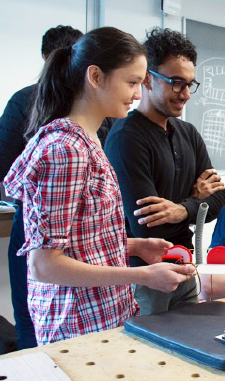 |
|||||||||
 |
 |
 |
 |
 |
 |
 |
|||
p r o t o t y p i n g (link) p o s t e r s & v i d e o s (link) c o u r s e p o l i c i e s (link) c o u r s e c u l t u r e (link)
|
|
C o u r s e C u l t u r e "In order to understand things, we have to build them." D E S I G N C U L T U R E - - - - - - - - - - - - - - - - - - - - - - - - - - - - - - - - - - - - - - - My courses foster a culture of design. Students with no coding or electronics experience have done well in this course. The Grove hardware kit components make "physical computing" accessible to the novice who is willing to "roll up the sleeves" and work at it. This course is foremost focused on "thinking big" and "thinking different" about designing interactive and adaptive systems that enable and augment people. It expects that you - with the best information you can acquire, and with your most intensive and exploratory effort - develop compelling, meticulously conceived and crafted interactive, physical things and environments responsive to challenges and opportunities of living. Given this ambition, I ask that you to take responsibility for your education by attending class, participating, and submitting and presenting assignments that advance thinking at the interface of design, engineering, computer science, and social science. C L A S S O R G A N I Z A T I O N - - - - - - - - -- - - - - - - - - - - - - - - - - - - - - - - - - - - -
For DEA 2730, 5210, and 6210, there is a specific organizational structure described in the course syllabus. Please note: I do not share my lecture slides. If you miss a class due to illness or for any other reason, we won't share slides with you or meet with you to repeat the lecture missed, Instead, we ask you to read carefully any assigned readings and review any linked materials for the missed class: the assigned readings and other materials convey the content of the lecture and/or discussion you missed. In missing a class, what you will miss is our class consideration of student work in-progress; it is however, difficult to capture what you missed of this class component. Accordingly, we encourage you to ask a classmate for a summary of this consideration of student work, and for any notes taken about it. Again, it is not the responsibility of the instructor or the TA to repeat the delivery of course sessions missed. D E S I G N C A R E E R S I N A N A .I . W O R L D - - - - - - - - - - - - - - - - - - - - Robert Capps. (2025). "A.I. Might Take Your Job. Here Are 22 New Ones It Could Give You. (In a few key areas, humans will be more essential than ever.)" The New York Times, Available at https://www.nytimes.com/2025/06/17/magazine/ai-new-jobs.html. Key point presented in 5 slides. Full article. D E S I G N S O C I E T I E S / J O B S / O P P O R T U N I T I E S - - - - - - - - - - I x D A , S I G C H I , & D R N CORNELL BOOM! REV START-UP ACCELERATOR
|
|
||||||
 |
|||||||||
|
|
|
|
|
|
|
|
|
|
|
